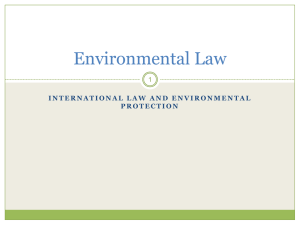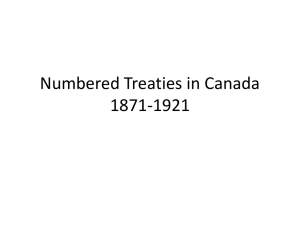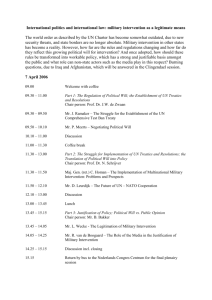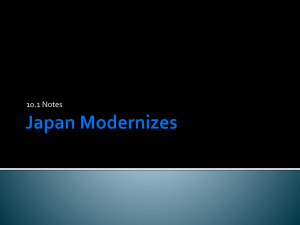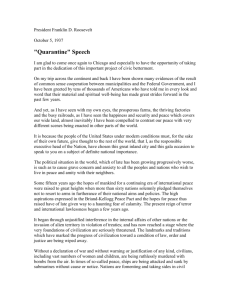CARe Reinsurance Boot Camp on Pricing Techniques
advertisement
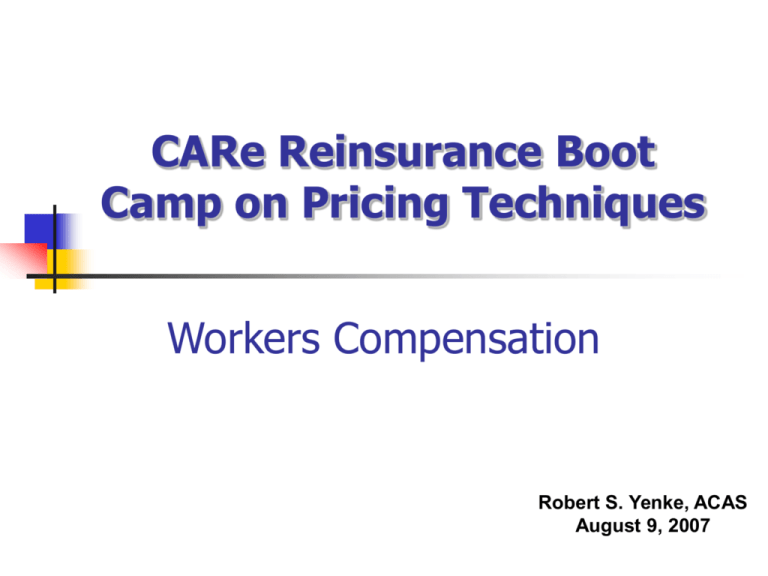
CARe Reinsurance Boot Camp on Pricing Techniques Workers Compensation Robert S. Yenke, ACAS August 9, 2007 The views and opinions expressed in this presentation are solely my own, and do not necessarily reflect the views or opinions of Odyssey America Reinsurance Corporation. 2 Outline Workers Compensation Background Quota Share Treaties Excess of Loss Treaties Catastrophe Treaties Facultative 3 Workers Compensation Background Started in U.S. in early 1900’s, before Social Security, before Federal Income Tax Withholding Benefits were low Early 1970’s National Commission of State Workers Compensation Laws Frequency declines, severity increases 4 Workers Compensation Background Independent Bureau states: California, Delaware, Indiana, Massachusetts, Michigan, Minnesota, New Jersey, New York, North Carolina, Pennsylvania, Texas, Wisconsin Monopolistic state Funds: North Dakota, Ohio, Washington, West Virginia, Wyoming 5 Workers Compensation Background Extremely long tail Annuity-type benefits for Survivors and Permanent Total claims Benefits defined by state law, not by courts Indemnity and Medical benefits Benefits, to some degree, vary by state No policy limits Essentially unlimited medical coverage No-Fault system 6 Quota Share Treaties Does the treaty cover losses up to a dollar amount, such as the first million, or the ceding company’s Net? If Net, what happens if the ceding company does not renew its Excess of Loss treaties? What if there is a loss above the top of the ceding company’s reinsurance? 7 Quota Share Treaties Quota Share up to a dollar limit - What is the cost of Excess of Loss reinsurance treaties? Compare Premium Net of Reinsurance Cost to Expected Losses at dollar limit Keep Actuaries Honest 8 Quota Share Treaties Is the ceding company writing Retrospectively Rated policies? If so, how are premium adjustments accounted for. Benefit level changes for states in analysis need to be included in estimate of projected loss ratio Use state specific trends if ceding company is predominately in only one or a small number of states In addition to filed rate changes, need to obtain impact of Schedule Rating, Group Discounts, etc. 9 Quota Share Treaties Standard Quota Share Treaty issues including: Ceding commission versus actual expenses, Impact of Sliding Scale Commission or Profit Commission What is considered ALAE vs. ULAE? What is included in definition of Subject Premium, e.g. Expense Constant? For smaller companies and start-up operations you can obtain state specific loss and ALAE ratios from bureaus – usually a little old 10 Quota Share Treaties Quota Share of Excess WC Insurance Who is handling the ground-up claims? Reinsurer is relying on Excess Insurer to audit original claims adjustors. There could be many different entities handling the claims – scary! 11 Excess of Loss Treaties Typical layers of $4M xs $1M, $3M xs $2M Working layers of $750K xs $250K, $500K xs $500K are less common than they used to be Occasionally there are requests for lower layers, but in most cases the primary company decides to keep the layer Net Some layers are unusual, such as $6M xs $1M, or $8.75M xs $1.25M 12 Excess of Loss Treaties Many treaties have free and unlimited reinstatements Some treaties have a limited number of free reinstatements, often expressed as a maximum aggregate recoverable e.g. $4M xs $1M with four reinstatements = $20M aggregate cap Usually the aggregate cap is set high, so there is a low a probability that it will be exceeded, still nice to have Some treaties have Annual Aggregate Deductibles 13 Excess of Loss Treaties Most treaties are flat rated Some treaties have adjustable features such as Swing Rating, Profit Commissions or Reinstatement Premiums The long loss reporting patterns make the number of potential premium or commission adjustments very large 14 Excess of Loss Treaties Claims WC Injury Types Death Permanent Total Major Permanent Partial Minor Permanent Partial Temporary Total Medical Only Only the first three impact most Excess of Loss Treaties 15 Excess of Loss Treaties Claims Some claims are recognized quickly as high cost, e.g. multiple person catastrophes Many claims are take years and years to develop into excess layer Injured Worker Mortality – how different from standard population mortality? 16 Excess of Loss Treaties Claims Workers have lower Mortality than general population Injured Workers identified as Permanently Disabled have similar Mortality as population Sometimes severely injured workers die before being classified as Permanently Disabled Medical care for WC injury may help early diagnoses of other issues Claims can develop adversely years later Family stops taking care of claimant Back injuries “creep” into the layer 17 Excess of Loss Treaties Loss Development Discounting of case reserves is standard Explicit: indemnity reserves on lifetime pension cases discounted: 3.5% interest rate common Implicit: medical – by not inflating projected future payments Mortality assumptions used in setting reserves; Bureau tables are used for Statistical Reporting, some companies have mortality tables that vary with injury severity. Effect of unwinding of discount can be much larger on an excess layer than the retained layer 18 Excess of Loss Treaties Loss Development Long payment pattern, explicit discounting of indemnity reserves, implicit discounting of medical reserves produces large Excess LDF’s Account specific LDF’s often have few claims, therefore LDF’s are volatile for higher layers RAA gathers data from reinsures every other year and publishes LDF’s by line of business In the 2005 study, WC Treaty data included Accident Years from 2004 back to 1958, 46 years! 19 Excess of Loss Treaties Loss Development My analysis produced a Treaty WC Incurred LDF from 12 months to ultimate of 11. Therefore, less than 10% reported after one year Gross Incurred LDF from 12 months to ultimate is 1.9 Treaty WC LDF from 156 months to ultimate LDF is 2. Therefore, after 13 years, only 50% of ultimate losses have been reported, the same as Gross LDF at 1 year! The Incurred LDF from 45 to 46 is 1.01, there is still IBNR at 45 years! 20 Excess of Loss Treaties Loss Development 2005 RAA Study included Paid Loss Development data My analysis of Treaty WC Paid LDF’s produced a 12 month to ultimate of 190; approximately 0.5% is paid at 12 months. The Gross LDF is 4.5 The Paid LDF to Ultimate reaches 2 at 22 years, i.e. 50% paid at 22 years, the Gross LDF is 2 at 2 years The Paid to Case Incurred Ratio at 46 years is 96% there are still open cases 21 Excess of Loss Treaties Impact on Reinsurer An injured worker is expected to live 10 years. Weekly indemnity benefits are 500/wk = 26,000/yr Expected indemnity benefit = 260,000 Discounted value at 3.5% interest = 220,000 Initial stabilizing medical expenses are 150,000 Annual medical expenses are 50,000/yr Expected medical benefit = 650,000 Undiscounted case reserve = 260K + 650K = 910K Discounted case reserve = 220K+ 650K = 870K Expected loss to the 1M xs 1M reinsurer is zero. 22 Excess of Loss Treaties Implicit Discount Effect Assume medical expenses are inflating at 6% per year Primary company books the ongoing medical loss at 500K, implicitly discounting them at 6%/yr. Total undiscounted ongoing medical expenses are really 680K instead of the booked 500K The total undiscounted loss is 260K + 150K 680K = 1,090K and the 1M xs 1M reinsurer will see 90K of loss development If the injured worker’s life expectancy is 20, 30, 40 or more years, the impact is much larger 23 Excess of Loss Treaties Mortality Assumption Effect Instead of a certain 10 year survival, there was a 50% probability of this worker living only 5 years and 50% of living 15 years. Losses paid if the claimant lives 5 years = 530K = 150K + (26K+50K) * 5 Losses paid if the claimant lives 15 years = 1,290K = 150K+(26K+50K) * 15 There is a 50% probability, the 1M xs 1M reinsurer will see no loss development and 50% probability the reinsurers will see 290K of loss development 24 Excess of Loss Treaties Trend The long tail and unlimited medical benefits add to the difficulty in estimating trends for Workers Compensation. In addition, states can – and do – change the WC benefits, adding to the uncertainty. 25 Excess of Loss Treaties Impact of Non-uniform Frequency Trend on Excess of Loss Pricing Exposure Rating Shape of the distribution changes, with more of the losses coming from larger claims Experience Rating Measured ground-up severity trend will increase from the reduced frequency of the smaller claims Assuming uniform trend by size of loss, the measured large loss trend will be lower than the measured ground-up trend This impact is mitigated by the less-negative frequency trend 26 Excess of Loss Treaties Trend Example Two types of claims, small and large. In year 1, small claims have average severity of 100K, while large claims have average severity of 500K. In year 1, there are an equal number of small and large claims, say 50 of each claim Total Losses are 30,000,000 Average Severity in year 1 is 300K = (50*100k + 50*500k)/(50+50) 27 Excess of Loss Treaties Trend Example, continued In year 2, there are now 40 small claims (frequency trend = -20%), while there are still 50 large claims (0% frequency trend). Total frequency trend = -10% The average severity for each claim type increases 10% Small claim severity = 110K Large Claim Severity = 550K Total losses are not 31,900,000 an increase of 6% But, the measured overall severity is now 354K = (40*110K + 50*550K)/(40+50) This is an 18% increase! 28 Excess of Loss Treaties Benefit Changes Most benefit changes are small, increase in maximum weekly benefit, change in burial allowance, etc. Large changes occur rarely, but sometimes in quick succession – impact by injury type can be vary California AB 749 January 1, 2003 PT Benefit Impact +54%, Overall Impact +5% California AB 227, SB 228 January 1, 2004, Overall Impact 9% California SB 899 April 19, 2004 Overall Impact -20%, January 1, 2005 Overall Impact -14% California January 1, 2006 Fatal Benefit Impact + 50%, Overall Impact +3% 29 Excess of Loss Treaties Experience Rating Paid losses projections are not usable Size of incurred LDF’s gives projections low credibility Presence or absence of large loss in a recent period produces large impact on projected losses to layer if LDF method is used B-F method, using Cape Cod method to estimate initial loss cost 30 Excess of Loss Treaties Experience Rating Higher layers may have no reported losses to develop. I do not want to compare a zero from experience rating to the loss cost obtained from exposure rating. Use ratio of exposure rating loss cost of higher layer to credible layer to apply to experience rating loss cost of credible layer 31 Excess of Loss Treaties Exposure Rating Workers Compensation is similar to other lines Compute overall expected losses Allocate these losses to the layer being priced by an industry size-of-loss curve 32 Excess of Loss Treaties Exposure Rating For lines with policy limits, like GL, the rating bureaus publish ILFs, which are based on size-of-loss curves But, WC doesn’t have policy limits. Reinsurers use Retrospective Rating’s Excess Loss Factors (ELF’s), even though they were not designed for reinsurance 33 Excess of Loss Treaties Exposure Rating Excess Loss Factors tables are published by state, typically for loss limits up to $10M, by Hazard Group Variations by state are due to differences in benefit levels Variations by Hazard Group are due to differences in the distribution of injury types by Hazard Group 34 Excess of Loss Treaties Exposure Rating 2004 ELF changes More reliance on state data Use empirical data for small claims, fit distribution for tail Distributions fit for Fatal, Permanent Total, Permanent Partial, Temporary Total and Medical Only Comparison to Prior ELF’s Percent of total losses in low layers, less than $1M similar to prior factors, some states increased, some decreased Percent of total losses in layers above $1M dropped significantly in almost every state 35 Excess of Loss Treaties Exposure Rating Comparison to Prior ELF’s Refitting current data using prior procedure produced ELF’s much closer to new procedure Conclusion – data, not procedural change, drove most of the reduction in percent of losses in high layers Decline in claim frequency in 1990’s changed the shape of the loss distributions 36 Excess of Loss Treaties Exposure Rating How Many Hazard Groups? NCCI and the other bureaus used four Hazard Groups, however, 95% of the premium was in Hazard Group II or III. Mining, explosive manufacturing, longshore, in HG IV. Much HG IV was in Assigned Risk Pools, so business written Voluntarily included very little HG IV business – excluded from many treaties – except for “incidental”. WCIRB adopted nine Hazard Groups A-I, which were subsequently updated to J-R. A four Hazard Group set of LER’s was produced – but class assignments did not match NCCI groupings. NCCI did there own study and selected seven. 37 Excess of Loss Treaties Exposure Rating Seven Hazard Groups are A through G, collapsible into four (1, 2, 3 and 4) A&B into 1, C&D into 2, E&F into 3, G into 4 Premium by Hazard Group is much more evenly split – Hazard Groups have really increased from 2 to 7 Improves estimates of losses by layer for reinsurers and for primary companies, for example Loss Rated Accounts 38 Excess of Loss Treaties Exposure Rating Suppose we’re pricing the $1M xs $1M layer Expected Loss Ratio = 70% ELF(1M) = 0.10; Losses in the layer = ELF(1M) – ELF(2M) = 4.0% 4.0% of the total losses are in this 1M xs 1M layer Exposure Loss Cost = 70% * 4.0% = 2.8% ELF(2M) = 0.06 39 Excess of Loss Treaties Combine experience and exposure loss cost Discount? Load for internal and external expenses When do you know true result? 40 Catastrophe Treaties Treaties requiring at least two injured workers, usually above $5M Maximum Any One Life (MAOL) Example: $5M xs $5M, $5M MAOL requires the total loss from one occurrence to exceed $5M, with no single injured worker contributing more than $5M Similarities to Property Cat Treaties 41 Catastrophe Treaties Reinstatement terms – frequently one reinstatement of limit with a premium expressed as a percent of original reinsurance premium. Reinstatement premiums are typically paid when losses are paid – which can be many years from inception, unlike Property Cat treaties. 42 Catastrophe Treaties WC Catastrophe Layers extend up to $100M and frequently higher, far beyond the ELF’s. Pricing is frequently expressed as Rate on Line – Premium / Limit Rates on Line vary by layer and exposure Higher layers have lower Rates on Line 43 Catastrophe Treaties Exposure is not necessarily correlated to Workers Compensation Premium – the Catastrophe risk is also related to Payroll Example – two employers with the same WC Premium but the first has a WC rate 10 times as high as the second. The second employer has a Payroll 10 times the first. The Catastrophe risk is not equal. 44 Catastrophe Treaties Earthquake exposed areas have higher Rates on Line Hurricanes are not considered a significant exposure for Workers Compensation – except for First Responders, most workers are not at work when the storm arrives Areas considered at higher risk for Terrorism have higher Rates on Line 45 Catastrophe Treaties Similar to Property Cat after Hurricane Andrew, information has increased Some submissions include information on Payroll/Premium/Employee counts by insured, or zip code, and time of day/shift or maximum exposed employee counts Similar to Property Cat, a number of reinsurers are needed to provide layers requested. Some participate on lower layers, others on higher layers. 46 Catastrophe Treaties As with Property Catastrophe, modeling firms are analyzing the exposures As with Property Catastrophe, reinsurers monitor their aggregate exposure to WC Catastrophe losses Potential exists for a Property Catastrophe loss and a Workers Compensation Catastrophe loss 47 Catastrophe Treaties Much of the business was written in the London market or by Life Insurers Terrorism was not recognized as a risk After 9/11, many participants suffered losses and left the market Rates on Line increased dramatically, attracting traditional reinsurers Coverage was restricted – i.e. limits on Terrorism 48 Catastrophe Treaties Rates on Line have been declining Coverage has been expanding – more Terrorism coverage, requests for including NBCR Fortunately, there have been no significant losses to this book of business since 9/11 Unfortunately, a significant Workers Compensation Catastrophe will eventually happen, whether a natural Catastrophe or a manmade Catastrophe As with Property Cat pricing after a large event, pricing will increase and coverage will be restricted. 49 Facultative Individual account pricing. By its very nature facultative reinsurance operates based on adverse selections. Through careful underwriting and pricing the reinsurers can establish the proper pricing and terms which would be profitable to the reinsurer. The ceding companies will place facultative reinsurance due to: class, exposures, to protect the treaty, a treaty exclusion or cat exposures. 50 Facultative Ceding companies are often looking for reinsurance in Buffer layers such as $750K xs $250K, $500K xs $500K Underwriters use a combination of loss rating and manual rating Loss rating up to a loss limit, usually well below reinsurance attachment point, then use ELF’s to estimate layer loss cost 51 Facultative Credibility weight loss rating with manual rating Load expected loss cost for internal and external expenses In the current market ceding companies want the WC facultative market to either match their pricing for the layer or be less than what they price it for. In the event that this can't be met then the ceding company would retained the risk Net. 52 Workers Compensation Suggested Reading Commentary on the New Hazard Groups by Jose Couret. Presentation at Spring 2007 CAS Meeting The 2004 NCCI Excess Loss Factors by Dan Corro and Greg Engl. CAS Forum 2006 An Actuarial Note on Workers Compensation Loss Reserves – 25 Years Later by Lee Steeneck. CAS Forum 1996 Ratemaking for Excess Workers Compensation Insurance, by Owen Gleeson. CAS Forum 2001 Levels of Determinism in Workers Compensation Reinsurance Commutations by Gary Blumsohn. Proceedings 1999 53

